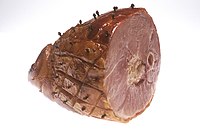
Incorporation of pig back fat in restructured dry cured ham to facilitate the release of unsaturated fatty acids and generation of volatile compounds
Sign Up to like & getrecommendations! Published in 2017 at "European Journal of Lipid Science and Technology"
DOI: 10.1002/ejlt.201600025
Abstract: The aim of the present study was to evaluate the effects of incorporating pig back fat in restructured dry cured ham (RDH) on its free fatty acid profile (FFA) and the volatile compounds released. Fresh… read more here.
Keywords: cured ham; back fat; pig back; volatile compounds ... See more keywords

Relationship between cyclopiazonic acid production and gene expression in Penicillium griseofulvum under dry-cured ham processing environmental conditions
Sign Up to like & getrecommendations! Published in 2019 at "Mycotoxin Research"
DOI: 10.1007/s12550-019-00357-9
Abstract: Cyclopiazonic acid (CPA)-producing Penicillium griseofulvum is usually found on the dry-cured ham surface during its ripening. The objective of this work was to evaluate the effect of temperature and water activity (aw) of dry-cured ham… read more here.
Keywords: cured ham; production; gene expression; dry cured ... See more keywords

Evaluation of main post-translational modifications occurring in naturally generated peptides during the ripening of Spanish dry-cured ham.
Sign Up to like & getrecommendations! Published in 2020 at "Food chemistry"
DOI: 10.1016/j.foodchem.2020.127388
Abstract: Peptidyl post-translational modifications (PTMs) could influence the final quality of processed meat. In this study, the peptide oxidative phenomena in Spanish dry-cured ham (Biceps femoris muscle) was evaluated at different ripening times (9, 12, 15,… read more here.
Keywords: cured ham; post translational; dry cured; translational modifications ... See more keywords

Laser-light backscattering response to water content and proteolysis in dry-cured ham
Sign Up to like & getrecommendations! Published in 2017 at "Food Control"
DOI: 10.1016/j.foodcont.2017.02.001
Abstract: Abstract Laser backscattering imaging (LBI) is a low-cost technology proposed to determine non-invasively composition and microstructural characteristics of agro food and dairy products. The aim of this work was to define the effect of different… read more here.
Keywords: cured ham; proteolysis; laser; water content ... See more keywords

Texture characterization of dry-cured ham using multi energy X-ray analysis
Sign Up to like & getrecommendations! Published in 2018 at "Food Control"
DOI: 10.1016/j.foodcont.2018.01.020
Abstract: Abstract Multi energy X-ray sensors are able to differentiate and quantify X-rays of different energies. In contrast to conventional sensors, which simply record the overall energy of the X-rays whatever the energy of x-rays is,… read more here.
Keywords: cured ham; energy; multi energy; energy ray ... See more keywords

Aspergillus westerdijkiae as a major ochratoxin A risk in dry-cured ham based-media.
Sign Up to like & getrecommendations! Published in 2017 at "International journal of food microbiology"
DOI: 10.1016/j.ijfoodmicro.2016.10.031
Abstract: Penicillium nordicum is well known for its ability to produce high amounts of ochratoxin A (OTA) in cured meat-derived products. On the other hand, Aspergillus westerdijkiae, one of the most relevant OTA-producing species of the… read more here.
Keywords: cured ham; risk; production; aspergillus westerdijkiae ... See more keywords

Iberian dry-cured ham as a potential source of α-glucosidase-inhibitory peptides
Sign Up to like & getrecommendations! Published in 2020 at "Journal of Functional Foods"
DOI: 10.1016/j.jff.2020.103840
Abstract: Abstract Iberian dry-cured ham is a meat product known as a source of different bioactive peptides due to its high protein content and intense hydrolysis during its processing. In this study, the potential of α-glucosidase… read more here.
Keywords: dry cured; cured ham; iberian dry; glucosidase inhibitory ... See more keywords

Proteomic footprint of ultrasound intensification on sliced dry-cured ham subjected to mild thermal conditions.
Sign Up to like & getrecommendations! Published in 2019 at "Journal of proteomics"
DOI: 10.1016/j.jprot.2018.10.002
Abstract: Ultrasound can intensify the heating process used to correct texture defects in dry-cured hams. The effect of ultrasound-assisted heating on the proteome of sliced dry-cured ham was evaluated. Dry-cured hams with high proteolysis index (PI > 36)… read more here.
Keywords: cured ham; proteolysis; proteomic footprint; sliced dry ... See more keywords

Effect of high pressure processing on the inactivation and the relative gene transcription patterns of Listeria monocytogenes in dry-cured ham
Sign Up to like & getrecommendations! Published in 2020 at "Lwt - Food Science and Technology"
DOI: 10.1016/j.lwt.2020.110555
Abstract: Abstract The population of Listeria monocytogenes and the expression of five virulence and stress-related genes in pressurized dry-cured ham were monitored throughout storage at 4 oC. L. monocytogenes strains S2 (serotype 1/2a) and S7-2 (serotype… read more here.
Keywords: cured ham; pressure processing; high pressure; dry cured ... See more keywords

Modelling the impact of water activity and fat content of dry-cured ham on the reduction of Salmonella enterica by high pressure processing.
Sign Up to like & getrecommendations! Published in 2017 at "Meat science"
DOI: 10.1016/j.meatsci.2016.09.014
Abstract: This work aimed to quantify the impact of aw and fat content of dry-cured ham on the Log reduction of Salmonella enterica by high pressure (HP). Dry-cured ham with adjusted aw (0.86-0.96) and fat content… read more here.
Keywords: cured ham; reduction; content; dry cured ... See more keywords

Association study between single nucleotide polymorphisms in porcine genes and pork quality traits for fresh consumption and processing into Italian dry-cured ham.
Sign Up to like & getrecommendations! Published in 2017 at "Meat science"
DOI: 10.1016/j.meatsci.2016.11.018
Abstract: Single nucleotide polymorphisms (SNPs) of six genes (TTN, PRKAG3, CAST, CTSB, CTSF, and MYPN), known for associations with carcass and meat quality traits, post mortem proteolysis, were screened in a commercial crossed population of 368… read more here.
Keywords: ham; cured ham; quality traits; nucleotide polymorphisms ... See more keywords